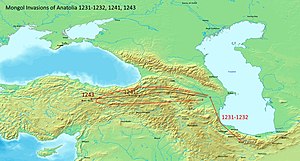
Back الغزوات المغولية في الأناضول Arabic Invasions mongoles d'Anatòlia Catalan Invasiones mongolas de Anatolia Spanish یورش مغولان به آناتولی FA Invasions mongoles en Anatolie French Mongolski podbój Anatolii Polish اناطولیہ اُتے منگول حملہ PNB Cucerirea mongolă a Anatoliei Romanian Монгольское завоевание Анатолии Russian Монголске инвазије на Анадолију Serbian
| Mongol invasions of Anatolia | |||||||
|---|---|---|---|---|---|---|---|
| Part of the Mongol invasions and conquests | |||||||
 Mongol invasions of Anatolia | |||||||
| |||||||
| Belligerents | |||||||
|
Anatolian beyliks | |||||||
Mongol invasions of Anatolia occurred at various times, starting with the campaign of 1241–1243 that culminated in the Battle of Köse Dağ. Real power over Anatolia was exercised by the Mongols after the Seljuks surrendered in 1243 until the fall of the Ilkhanate in 1335.[1] Because the Seljuk sultan rebelled several times, in 1255, the Mongols swept through central and eastern Anatolia. An Ilkhanate garrison was stationed near Ankara.[2][3] Remains of the Mongol cultural heritage still can be seen in Turkey, including tombs of a Mongol governor and a son of Hulagu.
By the end of the 14th century, most of Anatolia was controlled by various Anatolian beyliks due to the collapse of the Seljuk dynasty in Rum. The Turkmen beyliks were under the control of the Mongols through declining Seljuk sultans.[4][5] The Beyliks did not mint coins in the names of their own leaders while they remained under the suzerainty of the Ilkhanids.[6] The Ottoman ruler Osman I was the first Turkish ruler who minted coins in his own name in the 1320s.[7] Since the minting of coins was a prerogative accorded in Islamic practice only to be a sovereign, it can be considered that the Ottomans became independent of the Mongol Khans.[8]
- ^ Josef W. Meri, Jere L. Bacharach Medieval Islamic Civilization: A–K, index, p. 442
- ^ H. M. Balyuzi Muḥammad and the course of Islám, p. 342
- ^ John Freely Storm on Horseback: The Seljuk Warriors of Turkey, p. 83
- ^ Mehmet Fuat Köprülü, Gary Leiser The origins of the Ottoman empire, p. 33
- ^ Peter Partner God of battles: holy wars of Christianity and Islam, p. 122
- ^ Osman's Dream: The History of the Ottoman Empire, p. 13
- ^ Artuk-Osmanli Beyliginin Kurucusu, 27f
- ^ Pamuk A Monetary history, pp. 30–31